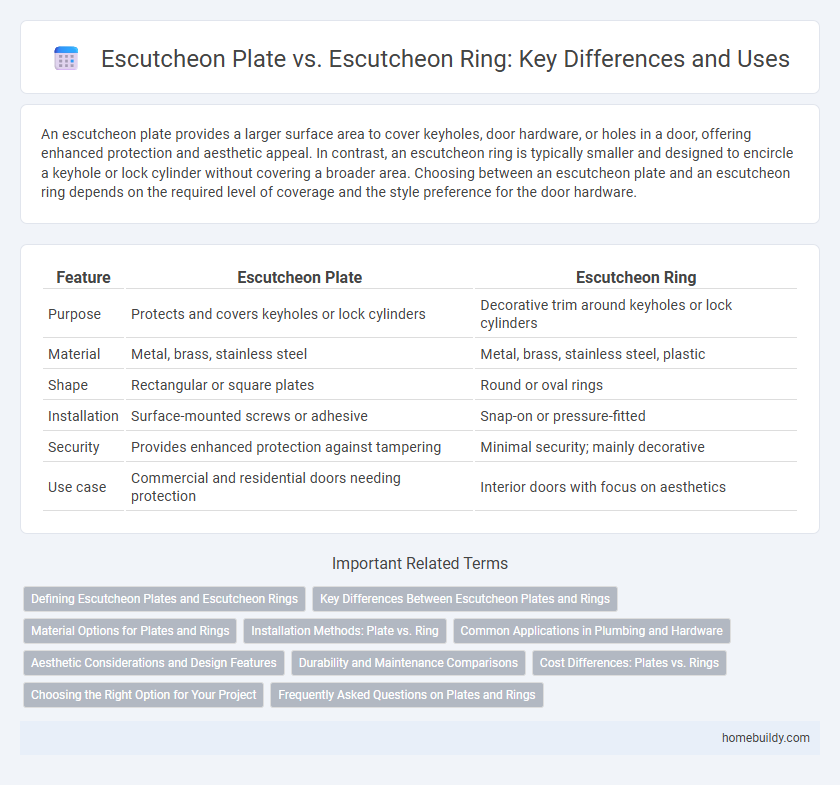An escutcheon plate provides a larger surface area to cover keyholes, door hardware, or holes in a door, offering enhanced protection and aesthetic appeal. In contrast, an escutcheon ring is typically smaller and designed to encircle a keyhole or lock cylinder without covering a broader area. Choosing between an escutcheon plate and an escutcheon ring depends on the required level of coverage and the style preference for the door hardware.
Table of Comparison
| Feature | Escutcheon Plate | Escutcheon Ring |
|---|---|---|
| Purpose | Protects and covers keyholes or lock cylinders | Decorative trim around keyholes or lock cylinders |
| Material | Metal, brass, stainless steel | Metal, brass, stainless steel, plastic |
| Shape | Rectangular or square plates | Round or oval rings |
| Installation | Surface-mounted screws or adhesive | Snap-on or pressure-fitted |
| Security | Provides enhanced protection against tampering | Minimal security; mainly decorative |
| Use case | Commercial and residential doors needing protection | Interior doors with focus on aesthetics |
Defining Escutcheon Plates and Escutcheon Rings
Escutcheon plates serve as protective or decorative coverings that shield keyholes or lock mechanisms on doors, providing a larger surface area compared to escutcheon rings. Escutcheon rings are typically smaller, circular fittings that surround keyholes or handles, offering a minimalist design focused on aesthetic enhancement. Both components function to protect door hardware but differ primarily in size, shape, and the extent of door surface coverage they provide.
Key Differences Between Escutcheon Plates and Rings
Escutcheon plates are larger protective or decorative covers surrounding keyholes, door handles, or locks, providing enhanced security and aesthetic appeal, whereas escutcheon rings are typically smaller, circular trims that accentuate or protect specific lock components. Plates often offer more extensive surface coverage and durability, making them suitable for high-traffic or external doors, while rings serve primarily as minimalist embellishments or localized protection. Key differences include the size, scope of coverage, and their functional versus decorative emphasis in door hardware applications.
Material Options for Plates and Rings
Escutcheon plates are typically made from durable materials like stainless steel, brass, and aluminum, offering enhanced corrosion resistance and structural stability compared to escutcheon rings, which often use softer metals or plastic composites. Plates provide a broader surface area for protective coating and finishes, making them ideal for both interior and exterior applications where weather resistance is critical. Rings, by contrast, prioritize lightweight and flexible materials, suitable for decorative purposes or indoor use with less exposure to harsh environments.
Installation Methods: Plate vs. Ring
Escutcheon plate installation typically involves securing the flat metal or plastic plate around a door lock or handle with screws or adhesive for a stable and decorative finish. In contrast, an escutcheon ring usually fits snugly around the lock cylinder or handle spindle and is often friction-fit or clipped in place, requiring less invasive installation. The plate method offers enhanced protection for the door surface and additional security against tampering compared to the more minimal coverage of the ring.
Common Applications in Plumbing and Hardware
Escutcheon plates provide a broad surface coverage for sealing wall or floor penetrations around pipes, commonly used in plumbing installations to prevent water damage and maintain aesthetic appeal. Escutcheon rings, smaller and less intrusive, are typically utilized in hardware applications such as covering small gaps around faucet or shower connections. Both components enhance the durability and finish of plumbing fixtures by protecting against moisture infiltration and debris accumulation.
Aesthetic Considerations and Design Features
An escutcheon plate offers a broader surface area, providing enhanced protection and a more substantial visual presence compared to the narrower escutcheon ring. The plate's design versatility allows for intricate patterns and finishes that complement diverse architectural styles, while the ring emphasizes minimalism and subtlety. Choosing between the two depends on the desired aesthetic impact and the balance between decorative detail and simplicity in door hardware design.
Durability and Maintenance Comparisons
Escutcheon plates offer greater durability than escutcheon rings due to their thicker construction and resistance to wear, making them ideal for high-traffic areas. Maintenance is simpler with escutcheon plates, as their larger surface area protects underlying wall or door materials from damage and requires less frequent replacement. In contrast, escutcheon rings tend to be more delicate, necessitating careful upkeep to avoid corrosion or deformation over time.
Cost Differences: Plates vs. Rings
Escutcheon plates generally cost more than escutcheon rings due to their larger size and additional material usage. Plates offer broader surface coverage and enhanced aesthetic appeal, which contributes to higher manufacturing expenses compared to the simpler, smaller rings. Budget-conscious projects often favor escutcheon rings for their affordability while still providing basic protection and decoration.
Choosing the Right Option for Your Project
An escutcheon plate offers broad surface coverage ideal for concealing larger holes or imperfections around door hardware, while an escutcheon ring provides a minimalist design suited for smaller, cleaner openings. Selecting the right option depends on the project's aesthetic and functional requirements, with plates favoring durability and concealment, and rings emphasizing sleekness and simplicity. Consider material compatibility, installation environment, and desired visual impact to ensure the chosen escutcheon enhances both security and style.
Frequently Asked Questions on Plates and Rings
Escutcheon plates provide a larger surface area for covering keyholes and hardware, offering enhanced protection against wear and tampering compared to escutcheon rings, which are narrower and primarily decorative. Frequently asked questions highlight that plates are better suited for exterior doors due to their durability and ability to hide imperfections, while rings are often used indoors for aesthetic appeal. Understanding the functional differences and installation contexts helps in choosing the right escutcheon type for security and design needs.
escutcheon plate vs escutcheon ring Infographic

 homebuildy.com
homebuildy.com